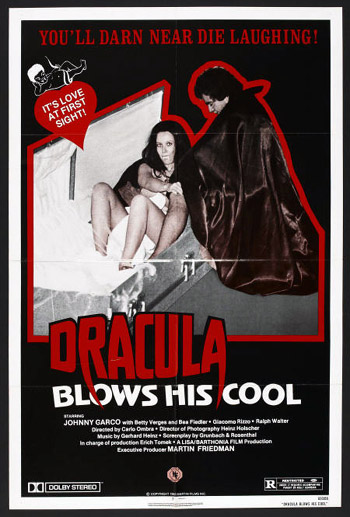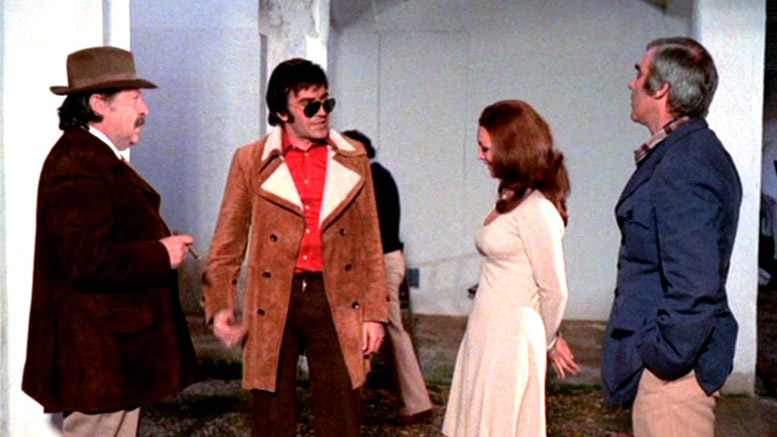
By the end of the 1970s, the exploitation genre was in something of a lull across the whole of Europe. In Germany, much as in Italy and Spain, the traditional genres were finding it hard to compete at the box office, and many of the films produced at the time have a slight feel of desperation about them. Lisa Film, for instance, were a fairly typical example of a German production house. Formed in 1965 and run by Karl Spiehs, they initially made their name making Heimat films, rural melodramas and comedies set against an Alpine backdrop, supplementing their output with a variety of spy films and westerns, generally made in collaboration with Italian or French companies. By the 70s, the Heimats had been usurped by sexploitation, and Spiehs wasn’t slow to join the trend, financing films such as Josephine Mutzenbacher and forming burgeoning relationships with the likes of Franz Antel and Hubert Frank. Towards the end of the decade, though, these films were being overtaken by the emergence of the hardcore market, and producers had to look elsewhere for marketable product, often attempting genre mash-ups in the hope of attracting as wide an audience as possible. Dracule Blows His Cool was a product of this time.
Stan van Skrew (Gianni Garko), the latest in a venerable line of Tyrolean aristocrats, hits upon a brilliant way of making a bit of dosh: turning the gothic monstrosity that is his family castle into a discotheque, the ‘Torture Chamber Club’. Sure enough, it proves something of a hit and the young people of the town turn up in their droves, perhaps attracted by the irresistible tones of ‘Rock Me Dracula’, an infectious piece of euro-pop that seems to be on constant play rotation. Unfortunately, not everybody is over the moon about this development. The prim schoolteacher, Mrs Nutracker (Ellen Umlauf), for instance, is particularly distraught about the licentious goings on at the club. Stan’s grandparents, also, are less than keen on all the noise that’s happening in their home; although, as vampires with a formerly erratic supply of blood, they’re not slow in seeing the opportunity presented by having hordes of nubile young females around.
Sure enough, they’re soon sinking their teeth into assorted members of Stan’s coterie. Dancer Linda (Linda Grondier) is the first to get the bite, followed shortly thereafter by self-styled vampire hunter Chubby (Tobias Meister). Poor Stan doesn’t have the faintest idea what’s going on, and he’s too preoccupied by the profits that are coming in and his sideline in erotic photography (‘I’m particularly impressed with your bizarre sense of sadism’) to take much notice. Fortunately, Mrs Nutcracker, who just happens to be the daughter of the famed Van Helsing, is also on hand; although she’s convinced that it’s the entirely innocent Stan who’s the vampire.
It’s hard to find fault, on a purely aesthetic level, with any film that makes such a majestic effort to fill the screen with naked babes frolicking in beautiful Tyrolean settings, even if the story and production values may be lacking a certain something. And actually, although Dracula Blows His Cool is undeniably inane, silly and crude, it’s a lot better than some of the other rubbish that was around at the time. It’s not badly made, and the saucy humour is rather innocent and endearing (how can you not laugh at a sequence in which a giant sculpted phallus is accidentally delivered to an old lady as a birthday present). Part of its appeal is undoubtedly down to nostalgia, but there are also some semi-decent ideas floating around – not least the fish-out-of-water experiences of the Victorian vampires in the then modern day – and it’s assembled with a certain amount of panache. Sure, it’s the kind of film with is liable to have mainstream critics throwing their notepads at the screen, but for the aficionado of the absurd and the eccentric, it’s not the worst way to spend 90 minutes (and it’s way better than Twilight).
This was the first film made by Swiss director Carl Schenkel, who also wrote, and he does a pretty decent job. He’d previously worked as an assistant director on such high-class productions as The Fruit is Ripe, Bathtime in Bangkok and She’s 19 and Ready, and he’d go on to forge a relatively distinguished career for himself, making a handful of moderately budgeted b-movies such as the interesting Knight Moves and Tarzan and the Lost City.
Gianni Garko’s career was, by this time, on the wane, and this was a rare opportunity to play the protagonist. He seems to be enjoying himself – heck, who wouldn’t, being surrounded by a horde of semi-naked Bavarian beauties – and hams it up shameless (and appropriately) as the crusty vampire. Neapolitan actor Giacomo Rizzo plays a Mafioso investor in the club, and was probably cast for international co-production reasons.
